Reay Golf Club - in balance with Mother Nature

Reay is proper Scotland, where the winds are 'lazy' and the scenery simply stunning. Heading north will take you past the Orkneys and on to the Shetland and Faroe Islands. After that, it's the arctic circle!
Golf, as an industry, has suffered from a poor environmental reputation in recent years. In some cases this is undoubtedly justified. However, it has been the actions of a minority that have led the wider public to believe that golf courses are "green deserts" utilising vast amounts of fertilisers, pesticides and water in order to provide a manicured playground for the wealthy. The negative stories of pollution and wildlife destruction are far more printable by the world's press and readable by the general public than stories to the contrary which highlight the positive roles that golf clubs play as custodians of the countryside.

Reay Golf Club is a prime example of how a combination of proactive management and minimal input can lead to a landscape that is visually attractive, a tough test for golf and, significantly, a diverse habitat for a variety of wildlife.
The course has often been described as a "hidden gem" and lavished with praise from some of the world's premier golfing authorities. However, its situation as the most northerly 18 hole golf club on mainland Britain means that the course is not inundated by golfers and is rarely included in the tours of golf courses undertaken by the thousands of visitors to Scotland each year. This has allowed the course to retain many traditional characteristics with minimal modifications. Vast numbers of visitors would undoubtedly lead to larger incomes for the club and with it, perhaps, the temptation of 'upgrading' the course for today's modern game.

Environmental issues have not always been at the forefront of the decision making process as they are now. However, the management of this traditional links golf course is inherently good for the environment and, therefore, has long been a truly sustainable golf club.
Grassland Management
Areas of deep rough are the defining characteristic at Reay Golf Club. They provide visual and strategic interest and a home to a host of wildlife.
It is important to note that these grasslands do not occur by accident and take proactive management if they are to be retained as good quality features of the golf course in the long term. If left without appropriate management, any grassland will try to follow the pattern of natural succession, first becoming dominated by the coarser and thicker grasses followed by woody scrub and tree species. The management of any particular grassland is dependent upon the species present and also its relationship to play on the golf course.
The grasslands range from young marram dominated areas interspersed with bare sand through to coarse agricultural style grasslands, with each requiring different management.
In general terms, infrequent cutting followed by collection of all arisings will be sufficient to retain a grassland in its current status, however, if a dense grassland is required to become thinner so as to facilitate speed of play or develop further wildflower and butterfly interest, the club will undertake scarification during the early part of the season in order to stress those competitive broad-leaved grasses in favour of the finer leaved grasses such as the fescues and bents.

In Scotland, there are thirty-two golf courses supporting SSSI designation, with the number exceeding one hundred throughout the UK. Scottish Natural Heritage (SNH) are the body responsible for ensuring that all SSSI sites are managed, such that the features and assets for which they were designated are retained in favourable condition in the long term.
Reay Golf Club has a strong relationship with SNH, with a bond of trust formed over many years of working together on the golf course. Potentially damaging operations, such as the construction of new tees, bunkers etc., application of pesticides or fertilisers or management of rough grassland can only be undertaken under licence from SNH.
The Sandside Bay SSSI extends throughout the northern section of the course incorporating areas to the east and west of Sandside Bay outside its perimeter. In addition to the above, a small pocket of land, known locally as 'The Sahara', is situated between the 1st, 3rd and 6th holes which, although separated from the more northerly sand dunes, does form part of the SSSI.
Sandside Bay SSSI is so designated for its interesting duneland floral communities and landscape characteristics. The vegetation throughout is largely dominated by marram grass, with tall herb species on the stabilised back slopes of the dunes.
Within the lower lying areas of the links, species rich short turf, supporting locally uncommon flora, such as cowslip and curved sedge, is also prevalent. The three burns which enter the SSSI - Isauld Burn, Reay Burn and Sandside Burn - also support interesting plant communities along their bank sides, including globeflower and rare sedges.

The golf course is flanked to the east by the Isauld Burn, to the west by Sandside Burn and is split through the central section by Reay Burn.
All three support a healthy and diverse ecological interest with small populations of brown trout, sticklebacks and minnow, easily identifiable in the deeper pools of each. The largest of the burns is Isauld to the west which is known to support small populations of migratory fish, such as sea trout and salmon.
Healthy amphibian populations reside in all three burns; with frogs, palmate newt and the internationally protected great crested newt, known to reside throughout these streams. A number of bird species are common visitors such as heron, cormorant, swallow and oystercatcher, all of which benefit from the carefully considered management of these water bodies.
The club aim to retain as much appropriately managed deep vegetation as possible along the bank sides of these burns, and in localised pockets within slower moving areas of the stream itself. These provide a home to a variety of invertebrates in addition to all of the above.
Rotational cutting and collecting of bank side vegetation is undertaken as advised by the club's professional ecologists in order to prevent any one species from becoming overly aggressive and reducing the diverse nature of the vegetation.
Summer flows of the three burns can be reduced to as much as a trickle which can lead to silt build up and algal growth requiring some localised removal in particularly dry years. Localised clearance is undertaken on a rotational basis, never removing more than 25% of the existing vegetation at any one time. This is undertaken at specific times of the year in order that breeding or hibernating species are allowed to fulfil their lifecycles without disturbance.

The obvious and overriding habitat throughout the course is grassland. What is not so obvious at first glance, however, is the diversity and number of different types of grassland throughout the site. Areas of deep rough can broadly be classified into several different types dependent on their species, structure and composition.
To the north of the course, the sea and underlying sandy soils have a strong influence on the types of grass and wildflowers which reside. Marram is known as a dune stabilisation grass and is one of the pioneer species to colonise bare sand. Its ability to spread via underground rhizomes makes this species perfect for consolidating loose sand, enabling other more opportunistic species to gain a foothold, as the bare sand begins to retain moisture and nutrients around those marram plants which initially colonised the site.

Further southward and away from the sea, the underlying soils are older and become more humus as the dead and dying pioneer grasses begin to die off and decompose in situ.
Often known as 'fixed dunes', these stable areas of land are dominated by finer leaved grasses such as red fescue and browntop bent, but also support some of the broader leaved species, including false oat-grass. A diverse and interesting floral community exists throughout such areas with plants easily found and identifiable such as lady's bedstraw, Scottish primrose, devil's-bit scabious, dog violet, ragged robin, red clover and globe flower all represented.
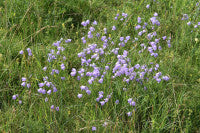
Butterflies and moths on the course
The following information is adapted from A Northern Study compiled by Mr James Gunn on behalf of the Northern Studies Centre in 1998.
Known locally as a lazy wind, in that it goes through you rather than round you, the northerly breeze which plays such an important part in the strategy of the golf course, might seem preventative for any weakly flying creatures such as butterflies or moths in setting up home in this environment.
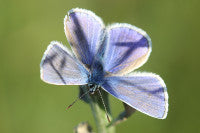
Given the diversity of habitats on the golf course, such as bare earth, scrub/rank grasslands, sand dunes and wetlands, the list of species is also diverse. Relatively common butterflies, such as large white, red admiral and painted lady are common place through the golf course, with species less typically expected in the links environment, such as dark green fritillary, clouded yellow, meadow brown and large heath have also been recorded.
The moths are a diverse and numerous group which are represented on the course and surrounding dune lands.
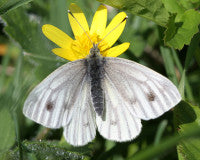
Late summer evenings are a good time to spot other species, e.g. the antler moth, which scatters its eggs over wet grassland, often alighting on the dune ragwort, or there's the pretty barred-yellow that pupates in the rolled up leaves of the dog rose. Another of the brightly coloured moths that haunts open areas is the garden tiger. Its bright colours act as a deterrent to predation. It is toxic, as is the hair caterpillar known here as the hairy brottag.
A moth sometimes found drawn inside the clubhouse by the lights is the large yellow underwing; with its wings folded, it is unobtrusive but, if stirred into fluttering, the bright colours of the underwing are startling.
This is only a small sample of the Reay moths and many more are to be found.
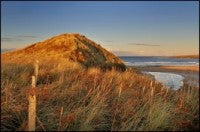
The dunes, on which the golf links are laid out, have taken thousands of years to grow and stabilise. They are the end product of a long battle between the force of the prevailing wind and the powerful waves of the Pentland Firth. Sand is blown off the beach beyond the reach of even the highest spring tides.
As the sand moves, it tends to collect together and is formed into ridges and mounds. Marram grass, which thrives in the dry sandy conditions, stabilises the dunes allowing other grasses and plants to establish themselves. The grasses and plants grow and gradually overpower the Marram. The depressions within the dunes provide shelter and attracts animals, which graze the established vegetation. The browsing of these animals is partly responsible for the existence of a smooth surfaced fairway mat, which needs little or no mowing. A prized asset.

Limited resources necessitate that inputs into management of the turf are kept to a minimum, yet the ultimate objective of providing a series of playing surfaces suitable for the game of golf is satisfied.
There is dominance of finer grasses, particularly fescue, indigenous to the site. The fescue and bent grasses dominate most of the playing surfaces across the course. As such, recently and much championed 'sustainable golf course management' is easily followed. Turf management is geared towards retention of the finer grasses.
Sensible cutting heights are employed throughout the year. The high content of fescue grasses through the sward means that winter heights of cut need little adjustment from those employed during the season. Greens, therefore, remain consistent and uniform for long periods of the year.
Fertiliser regimes are frugal. Ammonium sulphate based fertiliser is delivered to the turf in liquid formulation with seaweed. Nutrient is applied to greens on only two or three occasions during the season.

Below the playing surfaces, the soil profiles are consistently sandy and uniform; the need to hollow core greens is rarely necessary.
Topdressing through the season keeps the surfaces firm and smooth, allowing fast and trueball roll.
Turfgrass problems of disease and drought are rarely encountered, largely due the favourable botanical composition and sensible husbandry of the playing surfaces. Associated input of fungicide and water are, therefore, kept to a minimum.
Organic Waste Composting
Disposal of the fine leaved greens and tees clippings, which arise from the maintenance of any golf course, always pose management problems. This material does not compost well in its own right given its fine texture and lack of air spaces between particles. Its dissipation into areas of rough grassland often leads to their nutrient enrichment giving rise to a thickening of the sward and the loss of wildflower interest.
The club have developed a system whereby greens and tees clippings are temporarily stored in discreet bays around the golf course before being collected and taken to a central composting facility to the left hand side of the 6th hole. Here, they are mixed with cuttings from areas of deep rough grassland and other organic waste from the golf course.
This material is turned on an infrequent basis until useable compost is created. The compost is then screened and applied where necessary to the golf course as a topdressing, for example for tees and other heavy wear areas.
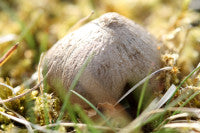
Often overlooked and unnoticed within grasslands, fungi are actually one of the most significant of wildlife groups. The type and diversity of grassland fungi noted within a particular area is directly related to the health and status of that habitat.
Species rich, unimproved grasslands will typically support several species of fruiting fungi specific to the environment. The windblown calcareous sands which dominate the links support several species of fungi which indicate a high quality, ecologically rich grassland.
Many of the fungi have not been allocated an English name. However, the wax caps, such as Hygrocybe splendidissima, Hygrocybe conicoides and Camarophyllus virgineus, are all interesting grassland fungi which can be noted fairly widespread throughout the course during late summer and autumn. The Japanese umbrella toadstool (Coprinus plicatilis) is another fungi which is widespread throughout the dunes and is particularly associated with heavily rabbit grazed grasslands.
All images ©Reay Golf Club/Evan Sutherland
